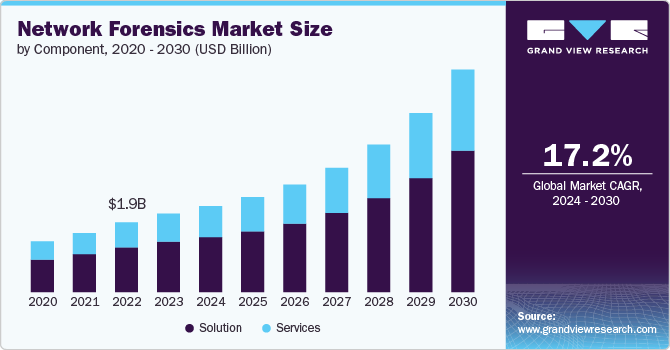Network Forensics Market Size, Share & Trends Analysis growing at a CAGR of 17.2% from 2024 to 2030

The global network forensics market size was estimated at USD 2.20 billion in 2023 and is projected to reach USD 6.23 billion by 2030, growing at a CAGR of 17.2% from 2024 to 2030. The rapid growth of IoT devices and connected infrastructures across various industries has introduced new security vulnerabilities, as these devices often lack robust security measures.
Key Market Trends & Insights
- The North America held the largest revenue share of over 36% in the market in 2023.
- The U.S. is growing significantly at a CAGR of 16.5% from 2024 to 2030.
- Based on component, solution segment accounted for the largest market share of over 63% in 2023.
- Based on deployment, on-premises segment held a market share of over 64% in 2023 and is expected to dominate the market by 2030.
- Based on organization size, large enterprises segment held a market share of over 69% in 2023 and is expected to dominate the market by 2030.
Market Size & Forecast
- 2023 Market Size: USD 2.20 Billion
- 2030 Projected Market Size: USD 6.23 Billion
- CAGR (2024-2030): 17.2%
- North America: Largest market in 2023
Request a free sample copy or view report summary: https://www.grandviewresearch.com/industry-analysis/network-forensics-market-report/request/rs1
Network forensics solutions play a critical role in monitoring traffic within IoT ecosystems, helping organizations detect and analyze unusual or malicious activities. By capturing and analyzing network data from IoT devices, these tools can identify threats such as unauthorized access, data tampering, or malware. This proactive monitoring is essential for securing IoT networks, mitigating risks, and ensuring the integrity of connected systems, which are becoming increasingly vital to modern business operations.
The network forensics market refers to the solutions and services used to monitor, capture, store, and analyze network traffic to detect and investigate cybersecurity incidents, anomalies, and data breaches. Network forensics tools and technologies help organizations trace the origins of cyberattacks, mitigate risks, and meet regulatory compliance requirements. These solutions provide deep visibility into network traffic, aiding in detecting insider threats, external cyberattacks, and breaches in real-time.
The rising frequency and sophistication of cyberattacks, including ransomware, advanced persistent threats (APTs), and data breaches, have significantly increased the demand for network forensics tools. These attacks pose severe risks to organizations by compromising sensitive data and disrupting operations. Network forensics solutions enable security teams to monitor, capture, and analyze network traffic to trace the origin of attacks, identify vulnerabilities, and uncover malicious activities. By providing detailed insights into how breaches occur, these tools help organizations not only respond to incidents quickly but also implement proactive measures to prevent future security threats and ensure compliance with regulatory standards.
Regulatory frameworks like GDPR, HIPAA, and PCI DSS require organizations to implement strict data security protocols and maintain detailed incident reporting and investigation capabilities. Network forensics solutions help companies meet these requirements by monitoring and analyzing network traffic to detect security breaches, ensure data integrity, and document cyber incidents. These tools provide insights into the nature of attacks, enabling organizations to respond quickly and maintain comprehensive audit trails for regulatory compliance. By securing sensitive data and ensuring prompt breach detection, network forensics helps businesses avoid legal penalties and ensure compliance with industry-specific security standards.






